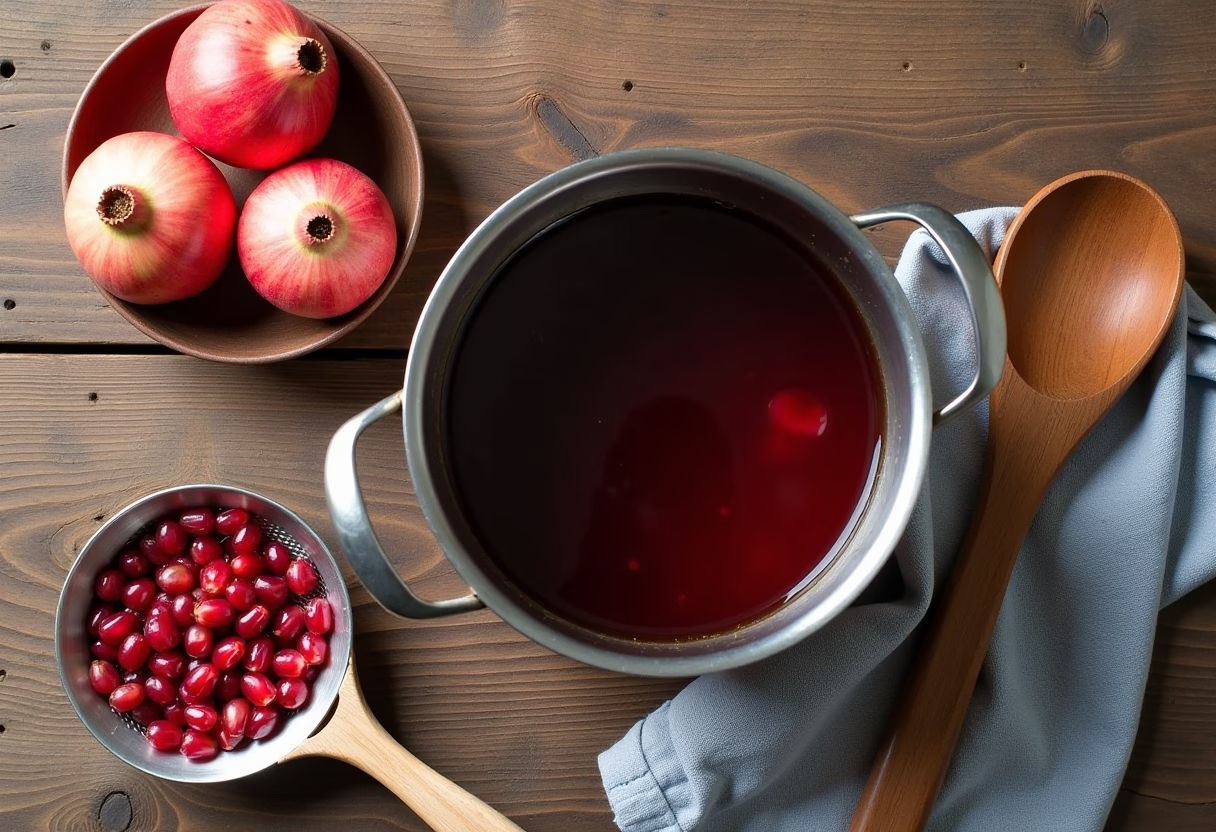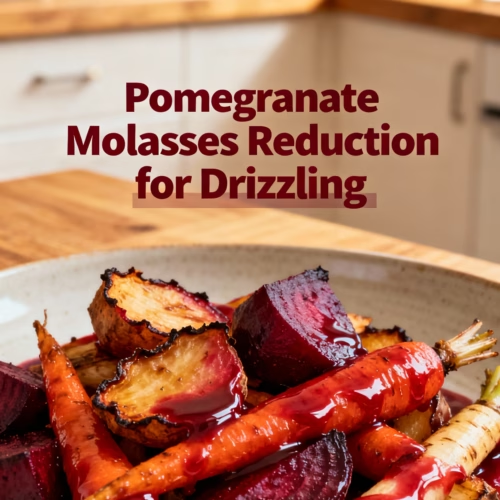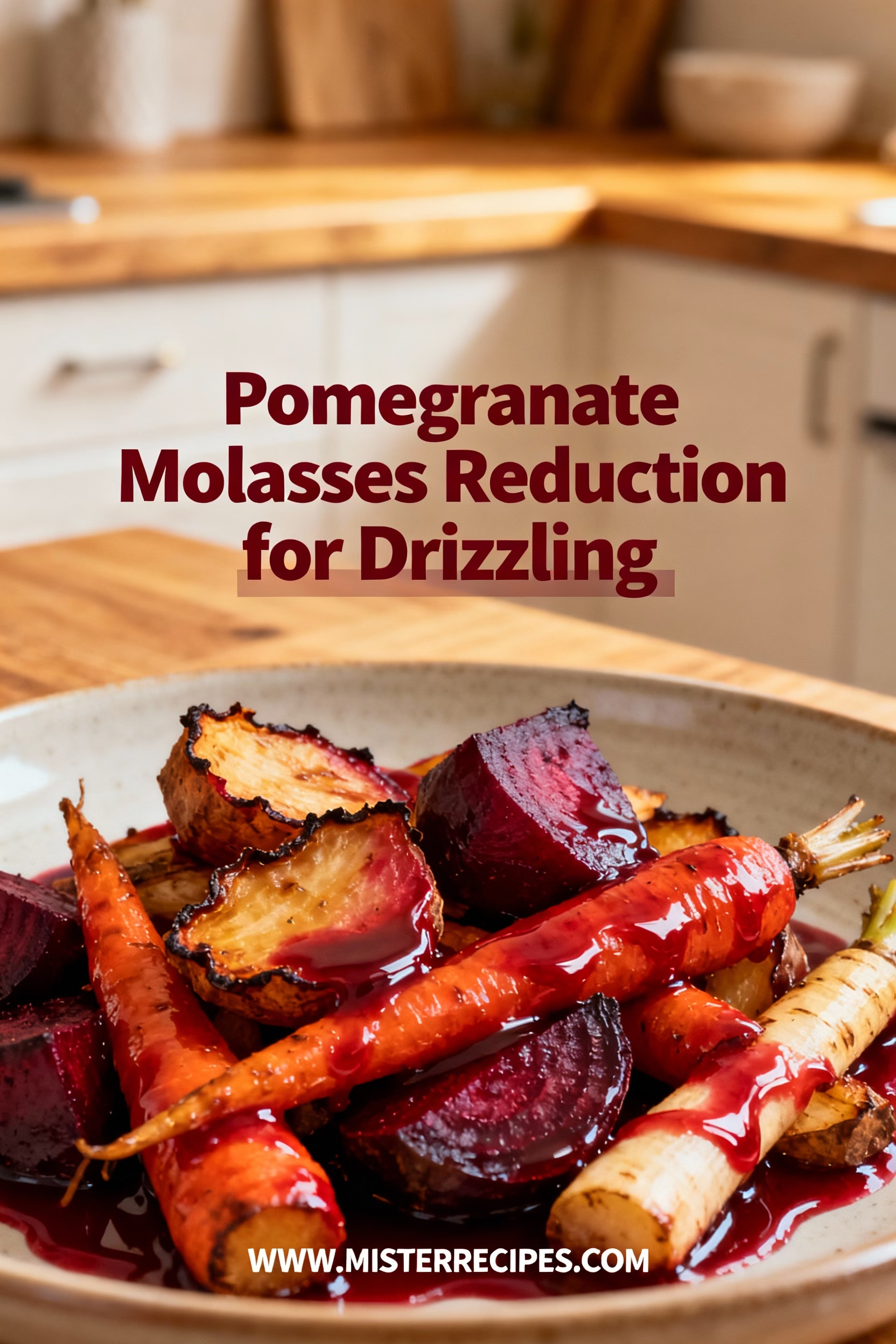Introduction
Have you ever wondered what transforms an ordinary plate into something utterly unforgettable? The secret often lies in a single, elegant drizzle. There’s a reason that chefs and home cooks alike reach for pomegranate molasses when they want to elevate their cooking from good to extraordinary. This tart, silky reduction has been used across Middle Eastern and Persian cuisines for centuries, yet it remains mysteriously underutilized in modern American kitchens. That ends today.
A pomegranate molasses reduction for drizzling is more than just a condiment, it’s an edible punctuation mark that finishes your culinary sentences with sophistication and depth. Made from just three simple ingredients, this homemade pomegranate molasses rivals anything you’ll find in specialty markets, and costs a fraction of the price.
I first discovered the magic of pomegranate reduction while testing recipes for a dinner party that felt, frankly, uninspired. The menu was fine, technically sound, but something was missing. Then I remembered watching my grandmother in her Minneapolis kitchen, how she’d finish dishes with a whisper of tart acidity, a flash of jeweled color. That’s what this syrup does. It wakes up your palate. It makes you pause between bites and ask, “What is that?”
The beauty of making how to make pomegranate molasses at home is that it requires almost no skill, no special equipment, and no exotic ingredients. You likely have everything in your pantry already. In less than thirty minutes, you’ll have a ruby-red reduction that will transform your cooking, whether you’re drizzling it over roasted vegetables, finishing a grain bowl, or adding unexpected depth to desserts.
This isn’t just another condiment. It’s confidence in a jar.
Why You’ll Love This Pomegranate Molasses Reduction for Drizzling
There’s a particular kind of joy that comes from discovering something so simple, yet so transformative. Let me tell you why this pomegranate syrup has earned a permanent place on my kitchen shelf.
You’ll love this recipe because:
• It takes under 30 minutes from start to finish. No complicated techniques, no babysitting required. Just bring juice to a gentle bubble, add sugar and lemon, and let time do the work.
• Three ingredients, endless possibilities. This is one of those rare recipes where simplicity isn’t a limitation, it’s liberation. You control the sweetness, the acidity, the intensity.
• It’s infinitely more elegant than store-bought. There’s something deeply satisfying about making your own pomegranate glaze at home. It tastes fresher, brighter, more alive than bottled versions. Plus, your guests will be genuinely impressed when you mention you made it yourself.
• It transforms ordinary dishes into restaurant-worthy creations. Whether you’re drizzling it over the simple green bean casserole, finishing roasted root vegetables, or topping creamy grain bowls, this reduction adds visual drama and sophisticated flavor.
• It’s naturally vegan, gluten-free, and shelf-stable. Once made, your pomegranate drizzle keeps for months in the refrigerator, making it perfect for meal prep and unexpected entertaining.
• It tastes like luxury on a budget. A bottle of premium pomegranate molasses at specialty shops can cost $12 to $18. You’ll make yours for about $3 to $4. The quality difference? Negligible.
Beyond the practical benefits, there’s something almost meditative about making this reduction. I often find myself at the stove on quiet mornings, watching the dark pomegranate juice slowly concentrate, breathing in that tart, almost perfumy aroma. It’s the kind of small kitchen ritual that reminds you why you love cooking in the first place. Not because you have to, but because the process itself is nourishing.
Ingredients for Pomegranate Molasses Reduction for Drizzling
For the reduction:
• 2 cups fresh pomegranate juice (or high-quality bottled, unsweetened)
• 2 tablespoons sugar (or honey for a slightly deeper flavor)
• 1 tablespoon fresh lemon juice
• Pinch of sea salt
Optional additions for variations:
• 1 cinnamon stick (for warmth and spice)
• 2 to 3 whole cloves (for subtle floral notes)
• 1 teaspoon pomegranate molasses concentrate (if you want to intensify the flavor)
• Fresh mint leaves (for brightness)
Substitutions and notes:
• If using bottled pomegranate juice: Look for 100% juice with no added sugar. The quality of your juice directly affects the final product. I prefer brands with minimal processing.
• Sugar alternatives: Use coconut sugar, agave nectar, or maple syrup in equal amounts. Each will add its own subtle character.
• Lemon juice swap: Lime juice creates a slightly different flavor profile, leaning more tropical. Champagne vinegar or white balsamic can substitute if you want deeper complexity.
• For a spicier version: Add 1/4 teaspoon cayenne pepper or a small pinch of sumac in the final minute.

How to Make Pomegranate Molasses Reduction for Drizzling
Step-by-Step Instructions
Step 1: Pour and Measure
Begin by pouring your pomegranate juice into a medium saucepan. Use fresh juice if you have access to it, or choose the highest-quality bottled juice you can find. I spend a few extra dollars on juice here because it’s literally the entire foundation of your reduction. Look for labels that say “100% pomegranate juice” with no added sugars or preservatives. Room temperature is fine. Take a moment to notice the color—that deep ruby red is what you’re going to concentrate and intensify over the next twenty minutes. This is the ingredient that will do all the visual work on your finished dishes.
Step 2: Bring to a Gentle Simmer
Place the saucepan over medium-high heat. You’re not rushing this. Let the juice warm gradually, watching as it begins to steam. Once small bubbles appear around the edges and a few break the surface, reduce the heat to medium. The goal is a gentle simmer, not a rolling boil. A rolling boil can cause the sugars in the juice to crystallize or caramelize unevenly, creating bitterness. You want a calm, steady reduction—imagine the surface of a quiet pond with occasional ripples.
Step 3: Add Sugar and Lemon
Once your juice is simmering, sprinkle in the sugar. Stir gently for about 30 seconds until the sugar completely dissolves. Now add the lemon juice. The acid is crucial here, it brightens the pomegranate flavor and prevents the reduction from tasting one-dimensional or overly sweet. Stir once more to combine, then step back and let the magic happen.
Step 4: Monitor and Wait (12 to 18 Minutes)
This is the patience part. Set a timer for 12 minutes, but understand that cooking times vary based on your stove, your saucepan, and the exact juice you’re using. While you wait, you don’t need to stir constantly. Check in every three to four minutes, giving it a gentle stir. What you’re watching for is volume reduction. Your mixture should reduce by approximately 50 to 60 percent. This means two cups of juice becomes roughly one cup of finished reduction.
The color will deepen dramatically. What started as bright, translucent ruby will become darker, more amber-tinged, richer. The aroma will change too, becoming more concentrated, almost wine-like.
Step 5: Test for Doneness
Here’s my favorite home-cook trick: use a wooden spoon. Dip it into the reduction, pull it out, and let a drop fall back into the pan. When it’s done, that drop should cling to the spoon briefly before dripping off, creating a light trail. It should coat the back of the spoon with a thin, glossy layer. If it still runs like juice, keep simmering. If it seems too thick and syrupy, you’ve gone slightly too far (no worries, it will still taste wonderful).
Step 6: Cool and Transfer
Remove from heat and let the reduction cool for five minutes in the pan. This cooling time allows it to continue concentrating slightly from residual heat. Then carefully pour your pomegranate molasses into a clean glass jar or bottle. I use wide-mouth mason jars because they’re easy to fill and store. Let it cool completely at room temperature before capping and refrigerating. As it cools, it will thicken further. When completely cool, it should have a pourable but syrupy consistency, somewhere between honey and maple syrup.
Step 7: Taste and Adjust
Once cooled, taste a tiny spoonful. Does it balance tart and sweet? Does it make you pause? If it tastes too tart, you can warm it again and add a teaspoon more sugar. If it seems too sweet, a squeeze of fresh lemon helps. This is your reduction, make it yours. But I find the original ratio hits that perfect note almost every time.
Pro Tips & Variations
Tip 1: Choose Your Juice Wisely
The difference between mediocre and magnificent pomegranate molasses reduction for drizzling starts with juice quality. Pomegranate juice can vary wildly in flavor depending on the variety of pomegranate, when it was harvested, and how it was processed. I prefer juice that tastes slightly tart and bright, never candy-like. If you have access to fresh pomegranates (September through November is prime season), you can juice your own using a manual juicer or food processor. Fresh juice yields a slightly more vibrant final product, though the difference is subtle.
Tip 2: Don’t Skip the Lemon
I know it seems counterintuitive to add lemon to pomegranate, but this is the secret weapon. The additional acid prevents the reduction from tasting one-note and enhances the natural tartness of the pomegranate. It also acts as a flavor brightener, making every drop taste more alive. This is what separates homemade from commercial versions.
Tip 3: Watch for the Finish Line
The most common mistake is over-reducing. Once your mixture reaches that glossy, spoon-coating consistency, stop. It will thicken more as it cools. If you continue cooking, it will become too thick and slightly bitter. Set a timer and check frequently in those final minutes.
Variation: Spiced Pomegranate Reduction
Add one cinnamon stick and two whole cloves at the beginning, letting them simmer throughout the cooking time. Remove them before jarring. This variation pairs beautifully with roasted root vegetables and pork dishes, and adds a subtle warmth without overwhelming the pomegranate flavor.
Variation: Pomegranate Molasses Marinade
Thin your finished reduction with a bit of olive oil and add minced garlic, cumin, and fresh herbs. This creates a pomegranate molasses marinade perfect for chicken, lamb, or vegetables. Use this for Middle Eastern-inspired dishes where pomegranate molasses serves as the flavor foundation rather than just a finishing touch.
Variation: Herbed Pomegranate Drizzle
Stir fresh mint, basil, or cilantro into your cooled reduction. This brightens the flavor and makes it particularly stunning over grain bowls or cheese plates.
Serving Suggestions
The true magic of pomegranate molasses reveals itself in how you use it. Here are my favorite ways to drizzle this ruby reduction into your cooking:
Over Roasted Root Vegetables
There’s a reason I come back to this pairing again and again. Roasted beets, carrots, parsnips, and Brussels sprouts all have a natural sweetness that deepens in the oven. A drizzle of pomegranate reduction adds tart complexity that makes you actually taste each vegetable more clearly. The acidity cuts through richness, the sweetness complements caramelization, and the color is absolutely stunning. Try this with crispy roasted Brussels sprouts for a side dish that steals the show.
Drizzled Over Grains and Greens
A simple bowl of farro, quinoa, or couscous transforms completely with a ribbon of pomegranate reduction. Pair it with roasted vegetables, some crumbled feta or goat cheese, toasted nuts, and fresh herbs. The reduction acts as both visual garnish and flavor bridge, bringing all the elements together. This is my go-to lunch when I need something nourishing and beautiful.
Finishing Cheese and Charcuterie Boards
A tiny drizzle over soft cheeses like burrata or goat cheese, or across aged hard cheeses, adds sophistication and an unexpected flavor note. Guests always pause and ask what it is. It pairs particularly well with walnuts, dried apricots, and creamy blue cheese.
On Top of Savory Soups
A small drizzle of pomegranate glaze across the top of butternut squash soup, cauliflower bisque, or even creamy vegetable soups adds visual drama and flavor complexity. The tartness cuts through cream beautifully.
With Roasted Meats and Poultry
This is where pomegranate molasses truly shines. A light drizzle over roasted chicken, duck, or lamb adds a tangy-sweet gloss that feels restaurant-caliber. The pomegranate molasses chicken preparations from Persian and Middle Eastern cuisines have taught us this pairing for centuries.
Over Desserts
This might seem unconventional, but a tiny drizzle of pomegranate reduction over vanilla ice cream, cheesecake, or chocolate mousse adds complexity and visual intrigue. It’s tart enough to cut through richness, sweet enough to feel intentional.
Storage and Reheating
Refrigerator Storage
Your finished pomegranate molasses reduction for drizzling will keep in a sealed glass jar in the refrigerator for up to three months. The high sugar content and acidity act as natural preservatives. It may thicken further as it cools and sits. If this happens and you want a more pourable consistency, simply warm the jar in hot water for a minute or two, or warm a spoonful in the microwave before using.
Freezing
You can freeze pomegranate reduction in ice cube trays, then transfer the cubes to a freezer bag. This is particularly handy if you make a large batch and want to use it gradually. Frozen cubes will keep for up to six months and thaw in minutes.
Signs of Spoilage
Because this is a concentrated reduction with a low water content, spoilage is rare. However, if you notice any mold, off smells, or fermentation bubbles, discard it. This has never happened to me, but it’s worth noting for food safety.
No Reheating Necessary
Unlike some sauces, pomegranate reduction doesn’t need reheating. Use it straight from the jar. It’s perfect at room temperature and actually becomes more flavorful as flavors meld over a day or two.
FAQ About Pomegranate Molasses Reduction for Drizzling
Q: Is pomegranate molasses the same as pomegranate syrup?
A: Yes, they’re often used interchangeably. Pomegranate molasses and pomegranate syrup are essentially the same thing concentrated pomegranate juice reduced with sugar. The term “molasses” refers to the thick, syrupy consistency. Some commercial versions may have slight variations in sweetness or added ingredients, but homemade versions are pure and straightforward.
Q: Can I use bottled pomegranate molasses concentrate instead of making my own?
A: Absolutely. If you prefer convenience, quality bottled pomegranate molasses is available at most specialty grocery stores and online. However, homemade versions cost significantly less and taste fresher. Plus, there’s something deeply satisfying about making it yourself.
Q: What if my reduction is too thick?
A: Warm it gently and stir in a tablespoon of pomegranate juice or water. This brings it back to pourable consistency without diluting flavor significantly. You can also warm individual portions as needed.
Q: How much pomegranate juice do I need for fresh pomegranates?
A: One medium pomegranate yields roughly one half to three-quarters cup of juice, depending on variety and juiciness. To make a full batch of reduction, you’d need approximately three to four fresh pomegranates. Bottled juice is more convenient and often yields more consistent results.
Q: Can I use this as a salad dressing?
A: Yes. Whisk the reduction with olive oil (roughly three parts oil to one part reduction), add a touch of Dijon mustard and minced shallot, and you have a pomegranate molasses salad dressing that’s stunning over bitter greens, grain salads, or roasted vegetables.
Q: Does homemade pomegranate reduction taste different from store-bought?
A: Yes. Homemade tastes brighter, more vibrant, and less one-dimensional. You control the sugar content and acidity, creating a more balanced reduction. Many commercial versions lean sweeter to appeal to mass markets.
Final Thoughts on Pomegranate Molasses Reduction for Drizzling
There’s a particular kind of kitchen confidence that comes from mastering a single, simple recipe so well that you make it without thinking. That’s what I want for you with this pomegranate molasses reduction for drizzling. Not because it’s complicated or precious, but because it’s so reliably elegant.
In my Minneapolis kitchen, on ordinary Tuesday nights, this reduction appears regularly. It’s there when I need to make simple ingredients feel special. It’s there when I want to acknowledge that cooking doesn’t have to be complicated to be meaningful. My children now ask for “the pomegranate syrup” the way other kids ask for ketchup. It’s become a staple, a signature, a small assertion that home cooking can be both simple and sophisticated.
I think of cooking as a language, and this pomegranate reduction is one of those words that works in almost every sentence. It belongs on your kitchen shelf the way salt belongs in your shaker. Make a batch this week. Notice how it changes your food. Then come back and tell me which dish you used it on first. I’d love to hear what you created.
Save this recipe to Pinterest. Leave a comment below if you make it. Subscribe so you never miss a recipe that will transform your ordinary meals into something worth remembering.
Your kitchen is waiting for this shimmer of ruby brilliance.

Pomegranate Molasses Reduction for Drizzling
Equipment
- Medium saucepan,
- Wooden spoon
- Glass Jar or Bottle
Ingredients
For the Reduction
- 2 cups pomegranate juice fresh or high-quality bottled, unsweetened
- 2 tablespoons sugar or honey for a slightly deeper flavor
- 1 tablespoon fresh lemon juice
- 1 pinch sea salt
Optional Additions for Variations
- 1 cinnamon stick cinnamon stick for warmth and spice
- 2-3 whole cloves whole cloves for subtle floral notes
- 1 teaspoon pomegranate molasses concentrate to intensify flavor
- fresh mint leaves mint leaves for brightness
Instructions
- Begin by pouring your pomegranate juice into a medium saucepan. Use fresh juice if you have access to it, or choose the highest-quality bottled juice you can find. Room temperature is fine.
- Place the saucepan over medium-high heat. Let the juice warm gradually, watching as it begins to steam. Once small bubbles appear around the edges and a few break the surface, reduce the heat to medium. The goal is a gentle simmer, not a rolling boil.
- Once your juice is simmering, sprinkle in the sugar. Stir gently for about 30 seconds until the sugar completely dissolves. Now add the lemon juice. The acid is crucial; it brightens the pomegranate flavor and prevents the reduction from tasting one-dimensional or overly sweet.
- Set a timer for 12 minutes. You’re watching for volume reduction—your mixture should reduce by approximately 50 to 60 percent. The color will deepen dramatically, and the aroma will become more concentrated.
- Test for doneness: dip a wooden spoon into the reduction, pull it out, and let a drop fall back into the pan. When it’s done, that drop should cling to the spoon briefly before dripping off, creating a light trail. It should coat the back of the spoon with a thin, glossy layer.
- Remove from heat and let the reduction cool for five minutes in the pan. Then carefully pour your pomegranate molasses into a clean glass jar or bottle. Let it cool completely before capping and refrigerating.
- Once cooled, taste a tiny spoonful. Adjust sweetness or acidity as needed by adding more sugar or lemon juice.




